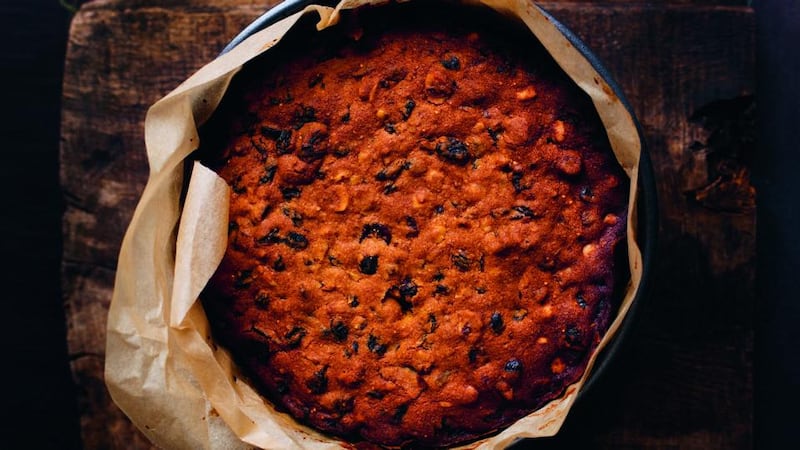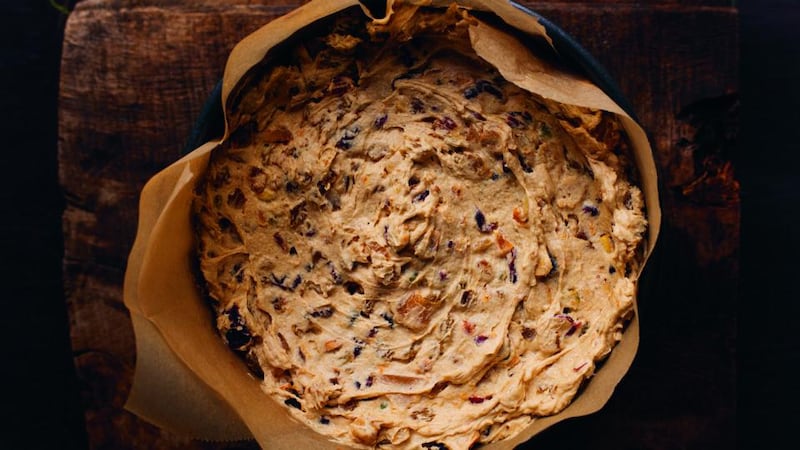Ingredients
- Butter – 250g
- Light muscovado sugar – 125g
- Dark muscovado sugar – l25g
- Shelled hazelnuts – 100g
- Dried fruits – ready-to-eat prunes, apricots and figs, candied peel, glacé cherries, 650g in total
- Large eggs – 3
- Ground almonds – 65g
- Vine fruits – raisins, sultanas, currants, dried cranberries, 350g in total
- Brandy– 3tbs, plus extra to feed the cake
- Finely grated zest and juice of an orange
- Finely grated zest of a lemon
- Baking powder – ½tsp
- Plain flour– 250g
Soaking the fruit: The counsel of perfection states to soak the dried fruit overnight in brandy and fruit juice. To be honest, I don’t bother, simply because dried fruits are not as dry as they once were, being generally more juicy and soft than in years gone by.
If you would like to do that, then put the vine fruits into a large mixing bowl, pour over the brandy and the orange and lemon juice, then steep overnight. An occasional stir will ensure as many fruits as possible stay in contact with the liquid.
You will need a deep 20cm-diameter round cake tin with a removable base, lined with lightly buttered baking parchment.

Set the oven at 160 degrees/Gas 3. Using a food mixer and a flat paddle beater attachment, beat the butter and sugars until light and fluffy. Don’t forget to push the mixture down the sides of the bowl from time to time with a rubber spatula.Toast the hazelnuts in dry pan until light brown, then cut each one in half.
While the butter and sugars are beating to a cappuccino-coloured fluff, cut the dried fruits into small pieces, removing the hard stalks from the figs. Break the eggs into a small bowl, beat lightly with a fork, then add a little at a time to the butter mixture, beating continuously. (If it curdles, add a little flour.)
Slowly mix in the ground almonds, toasted hazelnuts and all the dried and vine fruits, the brandy and citrus zest and juice. Now mix the baking powder and flour together and fold them lightly into the mix. Scrape the mixture into the prepared tin, smooth the top gently and put it into the oven.
Leave the cake for about an hour. Then, without opening the door, turn the heat down to 150 degrees Celsius/Gas 2 and continue cooking for one and a half hours.
Check whether the cake is done by inserting a skewer, or a knitting needle, into the centre. It should come out with just a few crumbs attached to it, no trace of raw cake mixture. Take the cake out of the oven and leave to cool before removing it from the tin.

Feeding the cake: If you make the cake early enough, or at least a month before you need it, you get the opportunity to “feed it” with alcohol. Most people use brandy, though I have known those who prefer rum. The trick is to pierce the base of the cake several times with a skewer, then spoon brandy into the holes. I have never found a skewer wide enough so tend to prefer a thin, ie Japanese, chopstick.
My mum, incidentally, used a knitting needle, a No 8, which provided a suitably wide hollow. I suspect she did this to ensure enough alcohol was absorbed by the cake rather than in memory of Ambrogio Lorenzetti’s 1345 painting of Mary, Joseph and the baby that clearly shows Mary clicking away on a pair of needles. One of a series of 14th-century paintings known as the “knitting Madonnas”.
The idea is to keep the cake moist and to help preserve it. I have a suspicion that the task isn’t really necessary, but the idea makes sense and I am happy to go along with it.
Once the cake is completely cool, remove the paper from the base and pierce all over with a skewer or knitting needle. Spoon over enough brandy to moisten the cake but not to make it soggy – I suggest three or four tablespoons at a time. Don’t use your best cognac, but it’s worth remembering that you can only take out what you put in. Wrap the cake in greaseproof paper and tinfoil and store in a cake tin. Feed the cake every few days with the same amount of brandy.
Recipe extracted from The Christmas Chronicles by Nigel Slater (published by 4th Estate). Photographs: Jonathan Lovekin








